Ochomilism
K2 is still the protagonist
K2 was, from the Himalayan perspective, the main protagonist of the year in which the highest mountains of the planet recovered their activity after a 2020 totally marked by the restrictions to mobility derived from the Covid pandemic. During the first weeks of 2021, the Chogori was the scene of a heroic and tragic epic at the same time, in which ten Nepalese took the glory of the first winter ascent of the last virgin eight-thousander in the coldest season of the year, while five other people lost their lives, including the Spaniard Sergi Mingote.
First K2 winter
The winter season on K2 concentrated an unusual number of climbers in four different expeditions, all of them eager to make their first ascent in winter. The undertaking was expected to be extremely difficult and risky, and for the first time it was the Nepalese Sherpas who took the helm of a project of such magnitude. They led three of the four expeditionary groups, which started working on the Abruzzo Spur route from the first day of winter... or even earlier in the case of the team formed by John Snorri, Muhammad Ali Sadpara and his son Sajid Ali Sadpara. The weather cooperated, the groups coordinated efficiently on the mountain, and progress was already evident by the end of December. After the first week of January, some of them were ready to attempt the summit as soon as the first window of good weather opened.
That window arrived on January 13 and the route was filled with climbers finishing the acclimatization phase, setting up high altitude camps and fixing ropes on the route. The Nepalese groups of Nims Purja and Mingma G were in the lead. An erroneous weather forecast on the 15th left John Snorri and the Ali Sadpara behind. Sergi Mingote and Juan Pablo Mohr were the closest team to the Nepalese that afternoon, but they considered that they were not sufficiently acclimatized to go beyond 7,000 meters at lower camp 3 and stopped there.
That same early morning, ten Nepalis led by Nims Purja and Mingma G,with Gelje Sherpa, Mingma David Sherpa,Mingma Tenzi Sherpa, Pem Chhiri Sherpa, Dawa Temba Sherpa, Dawa Tenzin Sherpa, Kili Pemba Sherpa and Sona Sherpa set off from C3 (7. 350 m) to traverse the Shoulder in the direction of the Bottleneck, overcome the serac traverse and finally reach the dream summit at five o'clock in the afternoon. With the sunset, they regrouped a few meters from the highest point and walked together that last stretch singing the national anthem of Nepal, in an image for history. Despite the fatigue and the lateness of the hour, they all completed the descent to C3 safe and sound. And even two of them, Gelje Sherpa and Sona Sherpa, made it all the way down to BC in one go. In the days that followed, it emerged that Nims Purja had made his ascent without the aid of supplemental oxygen, while his nine companions had used it.
Passing of Sergi Mingote
While the ten Nepalese were negotiating the upper part of the ascent of K2, Sergi Mingote and Juan Pablo Mohr, as well as other climbers who were on the mountain, were descending to base camp on January 16. Near the end of the descent, near Camp 1 of the Abruzzo Spur, Sergi Mingote fell to his death.
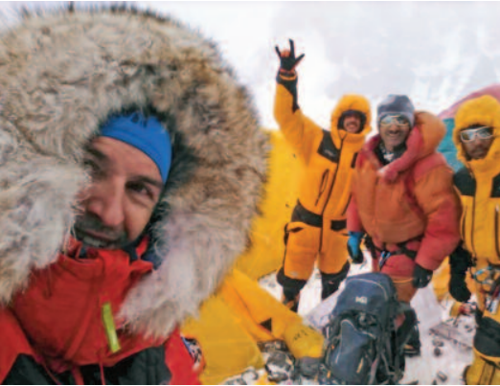
The Catalan climber, who in recent years had stood out for his activity in the eight-thousanders without oxygen, was one of the leaders of the Seven Summit Treks expedition and his death was a traumatic experience. It also represented a dramatic counterpoint to the success of the Nepalese.
Chaos and death in the second wave
While the ten authors of the first winter ascent of K2 left base camp and were literally engulfed by an ocean of celebrations, tributes and festivities in their country, the season continued on the mountain. The remaining climbers, belonging to two expeditions, still dreamed of reaching the summit. After two long weeks of waiting and recovering both physically and emotionally, a new possibility opened up at the beginning of February. A large number of climbers joined the attempt. However, the high altitude camps did not have the necessary equipment to accommodate them and scenes of chaos and tension ensued, first on C2 and then on C3.

The night before the theoretical summit day was an odyssey at Camp 3. There were no tents for everyone and no one was able to rest properly or melt ice to drink properly, as all the tents were overcrowded.
Despite this, John Snorri, Ali Sadpara and his son Sajid decided to leave for the summit at dawn, and they were joined by Juan Pablo Mohr without oxygen.

Tamara Lunger, the Chilean's new climbing partner, decided to turn around and set out on the BC route, as did the rest of the expedition. As soon as they started to descend, the experienced Bulgarian climber Atanas Skatov lost his footing and suffered a fall that would end his life.
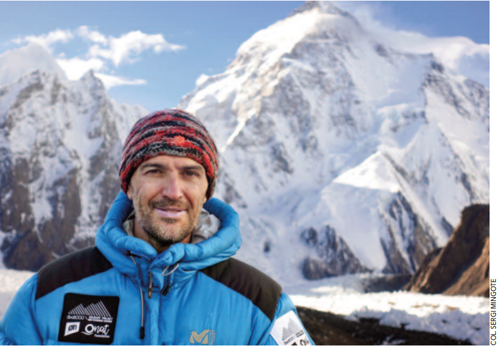
Meanwhile, the quartet attempting the summit was reduced by one before reaching the Bottleneck. Sajid Ali Sadpara had a problem with the oxygen regulator and returned to an empty Camp 3. His father Muhammad Ali Sadpara, John Snorri and Juan Pablo Mohr, continued on...
They would not return and would raise the winter death toll on K2 to five.
Summer epilogue
The disappearance of John Snorri, Juan Pablo Mohr and, especially Muhammad Ali Sadpara, motivated a great deployment of means. The rescue operation involved authorities, local guides, climbers from other countries, helicopters and state-of-the-art technology; later, it was transformed into a search operation for the bodies; and then it was cancelled until the summer.
In the most favorable season for climbing K2, Sajid Ali Sadpara returned with the objective of locating the body of his father and his companions, as well as to find answers to what happened. The young Pakistani climbed the Bottleneck behind the team of Sherpas responsible for equipping the route. The three bodies were found in different locations near the route: Juan Pablo Mohr near C4, Muhammad Ali Sadpara below the Bottleneck and John Snorri above the Bottleneck. All indications are that they died during the descent, probably succumbing to the cold and extreme fatigue. It has not been possible to conclude if they actually reached the summit or if they turned back before reaching it.
The other eight-thousanders of Karakorum
In addition to everything related to the winter K2 expedition, the Karakorum recorded some other relevant news throughout 2021. On the positive side, Niels Jespers and Hugo Ayaviri stood out.
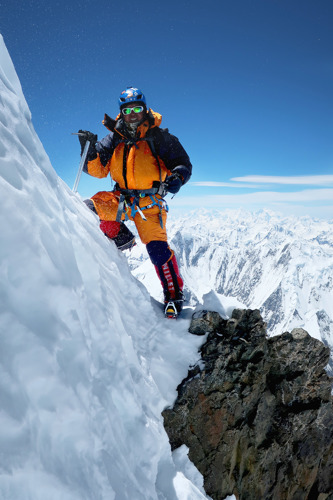
The Belgian and the Bolivian managed to link the oxygen-free ascents of Broad Peak and K2 in the ten days between July 18 and 28. Something that only eight people had done before them. In addition, Hugo Ayaviri still had time and energy to help Sajid Ali Sadpara move his father's body to a safer location near Camp 4 on K2. Meanwhile, Frenchmen Guillaume Pierrel, Aurélia Lanoe, Boris Langenstein and Tiphaine Duperier climbed Gasherbrum II and managed to descend it on skis, even though bad weather hampered work on the mountain and made their ascent a more technical game than anticipated. In the negative lake, the summer of 2021 in the Karakorum eight-thousanders will bear the name of Hong-bin Kim.
The 57-year-old Korean mountaineer, an amputee of all fingers on both hands since 1991, completed the ascent of all fourteen eight-thousanders at the summit of Broad Peak. However, he lost his life in a fall during the descent, still at the top of the mountain. Once again, the situation was unclear, with several climbers passing close to the crevasse where Kim had fallen without helping him.
The true summit of Manaslu
In the fall, the action in the eight-thousanders moved to Nepal, where the community that lives from and for the mountains longed for a season of some normalcy after seeing the cancellations of 2020 in the many problems caused by the Covid contagions in the spring expeditions. Fortunately, this time it was possible to enjoy that relative normality.
As usual, Manaslu concentrated the largest number of people of the post-monsoon season, integrated in numerous commercial expeditions led by Sherpas. The extraordinary thing about the season was that one of these expeditions, led by Mingma G, went off the pre-established script to climb the true summit of Manaslu, overcoming the controversy raised by research that placed the highest point at the opposite end of the ridge to the one usually taken for the real summit.
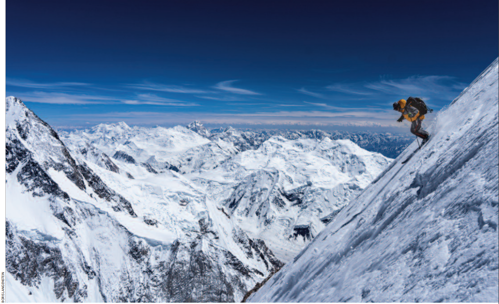
With the help of some impressive images taken by Jackson Groves, the issue became crystal clear and showed that only the Mingma G group had reached the actual summit. And not only this year, but the mistake goes back a long time.
Thus, even "The Himalayan Database" had to take a position and warned that from 2022 onwards it will no longer accept summits that do not correspond to the real summit, although it will not carry out a revisionist exercise with ascents from previous years.
Among these ascents will be that of Martín Ramos, who managed to reach the tenth eight-thousandth of his particular account on Manaslu. As well as that of Anna Tybor, who completed the first female descent on skis of the eighth highest mountain in the world.
Batard variant on Everest
The autumn season in the eight-thousanders was extended this year until the end of November. It was the solitary season chosen by veteran Marc Batard to carry out an expedition ahead of his ambitious project to climb Everest without oxygen at the age of 70 in 2022. The French mountaineer led a team with his son Alan Batard and several mountain guides to open a variant of the normal route on the south slope to avoid the dangerous passage through the Khumbu Icefall.
The nicknamed "Everest Sprinter" announced they had achieved their goal, via a line ascending a rocky section of the Nuptse flanks (up to about 6000 m) from Gorakshep (5150 m) and including the summit of an unnamed 5880 m peak they named Sundare, in honor of Batard's 1987 Dhaulagiri partner Sundare Sherpa, who died in 1989.
The Batard variant would link up with the oroginal route at some point near Camp 1, just past the Khumbu Icefall in the Valley of Silence. But this will be a pending story for 2022.
Isaac FERNÁNDEZ
Lessons from altitude
During the first attempt on Broad Peak, Anne climbed up to C2, from where she made an epic descent in the middle of a storm and decided not to attempt it again, helping since then in the logistics and success of her husband's goals. Hugo managed to reach the summit of the Broad on the second attempt (July 18) and, just 10 days later, linked up with the summit of K2, together with Polish Oswald Rodrigo and Belgian Niels Jespes.

He climbed both ascents without oxygen and without the help of Sherpas, thus becoming the first Bolivian to achieve this feat, and the ninth person in the world. On the Broad, Hugo helped rescue the Russian Nastya Runova and experienced first-hand the death of the Korean Hong-bin Kim.
Also in those days, the memorial ceremony for those who died on K2 the previous winter took place, and Hugo helped Sajid to lower the body of his father, Muhamad Ali Sadbara, from 8300 m to 7900 m (at C4, where he was buried), for which he was received as a national hero in Pakistan. Anne shares her thoughts below after witnessing and participating in all these events first hand.

Scenarios repeat themselves, stories happen and they are the same! After the good weather, the storm... after the success, the anguish and tragedy... Climbing to the top within reason has always been a fatal mistake.
This year, Broad Peak candidates spent 24 hours between the ascent of Rocky Summit and, for some, the actual summit.
But they arrived too late, too late in the afternoon and made it to Camp 3 during the night, and for some they almost didn't make it back or stayed there! This mistake is frequent and very often tragic. Once again, this proved to be true with the fall of Naztia and Mister Kim.
Equipping the route with fixed rope on the same day from the weather window while clients wait behind them also seemed foolish to me. The Sherpas can afford it, they master the technique and timing perfectly. Every mistake comes at a high price at this point.How is it also possible that they did not provide enough fixed rope to equip all the way to the top of Broad Peak? This year, the absence of the Sherpas was painfully felt. It was an opportunity for the Pakistanis to show that they were capable of equipping the routes themselves, but it is clear that they still lack training and professionalism.
Human beings at 8000 m
I had the feeling that the atmosphere on this kind of expedition was going to be very different from what I was experiencing in my own mountains.
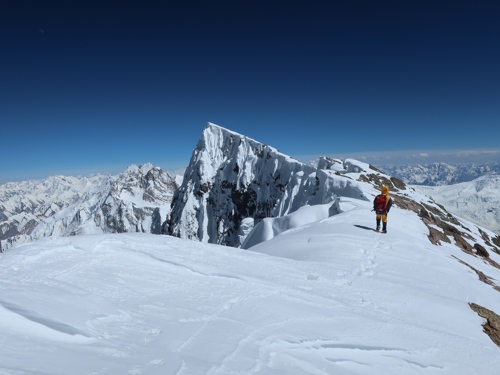
I made some great connections: fantastic, warm, supportive and interesting people. I can say that I made some real friends. But I also discovered an overrated and dehumanized world. How would you rate human beings at 8000 m? Dehumanized, jealous, individualistic and selfish.
The team spirit is gone, the concept of cordage is gone, the solidarity I knew no longer exists! Everyone works for his own interest. Everyone feels good in his own bubble. The only goal that matters is everyone's individual goal. If you don't reach the top, the human being will look for excuses or a good reason not to have done it, and the excuse of rescue is often ideal. Everyone pulls for his own side, and the base camp becomes a place where there are lies and slander. Everything is speculated, negotiated? And yet, it seems that this is nothing compared to the operation carried out during the commercial expeditions in Nepal. I don't know what to make of all this, but this is not the image I love of the mountains. The economic challenges are many. Money rules the world, and at 8000 m it is even more true!
Fear, the great problem
Fear is a real problem at these heights. This is very often what paralyzes the unprofessional mountaineer. Very often it is also contagious. The real problem is that we feel very lonely clinging to our rope.
In the Andes, I climb with my guide, who secures me with his rope. Then I feel capable of doing great things. Here, I am hanging on to a rope whose insurance is random. Above 7000 m, we know very well that, in case of a problem, almost nobody will be able to help us. You have to be very independent, which is not the case for me as an amateur mountaineer. Rescues like Natzia's rescue by Oswald are very rare. Suddenly, the anguish of death overwhelms you, reason wins and pushes you down.
This year, the summits were not well equipped all the way to the top. During the first attack on the summit of Broad Peak, only the strongest climbed: Hugo, Oswald and Niels, as well as Naztia and Mister Kim, as well as one person with oxygen. Some Pakistani porters had followed them. During the second attempt, which was to be made on the morning of July 27, contagious fear gripped the 22 summit candidates, who gave up because of the risk of an avalanche. Fear prevailed over collective opinion. We convince ourselves that the situation is too dangerous, zero risk does not exist on the mountain, but when fear has invaded us it is impossible to reason, the excuse is serious and spreads throughout the group like a trail of gunpowder. The notion of survival wins.
Anne BIALEK